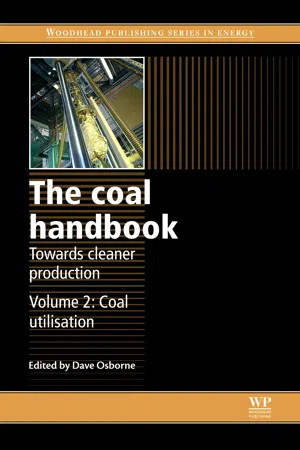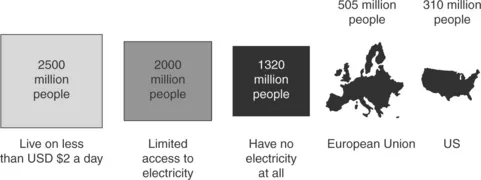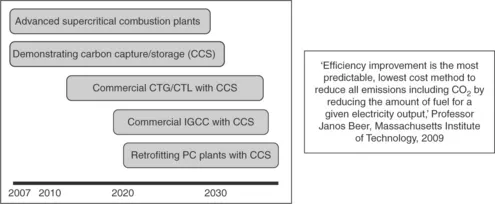Abstract:
As the world’s leading source of electric power, coal is the continuing cornerstone of economic development, social progress, and a higher quality of life. Coal is powering the twenty-first century economic miracles rapidly unfolding in China and India, as reliability, affordability, and availability make coal the fuel of choice in the developing world. Demand modeling from both the International Energy Agency and US Energy Information Administration indicates that coal will provide the most amount of incremental energy over the next two decades. Looking forward, with the expanding implementation of clean coal technologies, the door to coal’s global leadership role will remain open as the world strives to meet the ever-rising demand for energy while reducing greenhouse gas emissions.
1.1 Introduction
Coal is the continuing cornerstone of economic development, social progress, and a higher quality of life. Across the world, more coal means more people living better and living longer. Coal was the backbone of the Industrial Revolution in England during the eighteenth century, America’s emergence as a major economic power during the late nineteenth and early twentieth centuries, Germany’s manufacturing prowess during the early twentieth century; and coal is now powering the twenty-first century economic miracles rapidly unfolding in both China and India. Today, coal supplies a leading 40% of the world’s electricity, and coal’s availability, affordability, and reliability make it the fuel of choice in the developing world. The Copenhagen Accord in 2009 identified two crucial challenges at the global level, both of which have implications for the industrial utilization of coal: first, the need for the nations of the world to meet the growing challenge of climate change and ‘cooperate in achieving the peaking of global and national emissions as soon as possible’; and second, the need to ‘bear in mind that social and economic development and poverty eradication are the first and overriding priorities of developing countries’ (United Nations Framework Convention on Climate Change, 2009).
1.1.1 Energy deprivation and its consequences
Energy deprivation is a global blight. In the World Energy Outlook 2011, the International Energy Agency (IEA) estimates that 2.5 billion people live on less than $2 a day, over 1.3 billion people, nearly 20% of the global population, are totally without electricity and at least another 2 billion have highly constrained access (see Fig. 1.1).According to the World Bank’s World Development Indicators (2011) and the United Nations Development Programme (2011), well over 4 billion people, at least 60% of the world’s population, use fewer than 2350 kWh per year, or only a third as many as the typical European.
1.1 The scale of global poverty. (Source: World Bank 2011; International Energy Agency 2011.)
Unfortunately, the IEA (2011) projects that 16% of the global population in 2030, 880 million people, will still lack access to electricity, the sine qua non of modern civilization. At the same time, calls to reduce emissions 80% by 2050 face the powerful headwind of rising energy demand due to economic growth, increases in population, and an ever greater proportion of people living in cities. The world needs much more energy, particularly electricity, while at the same time significantly reducing greenhouse gas (GHG) emissions including those of carbon dioxide (CO2).
1.1.2 The role of more efficient coal technologies and carbon capture and storage
This chapter is founded on the premise that increased coal-based generation efficiencies, coupled with carbon capture and storage (CCS), can help the world meet the goals of a significant reduction in CO2 emissions amid sustained economic growth and the eradication of poverty and elimination of energy deprivation. The IEA’s Coal Industry Advisory Board (2009) has stated the world’s energy reality succinctly:
• The future use of increasing quantities of coal worldwide is inevitable if the world is to avoid a damaging energy crunch and support the development needs of poorer nations.
• The mitigation of CO2 emissions from current and higher future global energy use will require the deployment of all forms of currently available response including substantial investments in renewable energy and nuclear power.
• Improving the efficiency of both existing and future coal-fired power plants has the potential to generate significant and cost-effective emissions reductions, and must be a priority for all coal-using countries.
• Various studies have reinforced the importance of CCS as a cost-effective and critical component of climate change goals.
In order for the world to meet both economic and environmental goals, emerging giants like China and India must be able to significantly expand their coal consumption while reducing their emissions. Clean coal is their chosen path forward. Clean coal technologies, especially the dramatically improved power plant efficiencies available now, are the means to meeting both burgeoning global energy demand and climate policy goals. The rapidly evolving technology of CCS will be the crowning next step to near-zero emissions and will be deployable at scale early in the 2020s. Until that point, large supercritical (SC) and ultra-supercritical (USC) coal plants capable of CCS retrofit will allow countries like China and India to meet immediate needs with significantly reduced emissions per kilowatt-hour (kWh) (Fig. 1.2). Going forward, this powerful tandem of higher efficiency and CCS will unlock the full value of the world’s most abundant energy resource – coal.
1.2 A path to near-zero emissions.
The current chapter focuses on the global value of coal and the opportunities that clean coal technologies present to continue and expand utilization of this vast energy resource, thereby allowing coal to continue to play a significant role in the world’s socioeconomic and environmental goals. Climate objectives and the eradication of poverty are complementary, not conflicting, goals. They are compatible and represent an achievable future for all societies. Indeed, it is the authors’ opinion that the major challenge of our time is not merely to reach 2050 with a decrease in GHG emissions but also to create reliable access to electricity access for all, and that coal is the answer for measurable reasons.
1.2 The importance of electricity and low cost power
‘… high rates, of course, bear hard on the individual. But from a social standpoint they are chiefly to be regretted because they restrict the use of electricity. Rate schedules should be so adjusted as to induce the freest possible use of electricity both in the home and on the farm Franklin D. Roosevelt, then Governor of New York, 1930
Analysis of the environmental implications associated with society’s use of fossil fuels and the emission of GHGs – particularly CO2 – often focuses on the potential for climate change impacts. But, in the context of assessing the societal risk of CO2 emissions, it is important to also focus on the reasons why CO2 is even emitted in the first place. CO2 is not released in a socioeconomic vacuum. CO2 is emitted because it is the inevitable byproduct of combusting fossil fuels, the foundation of th...


